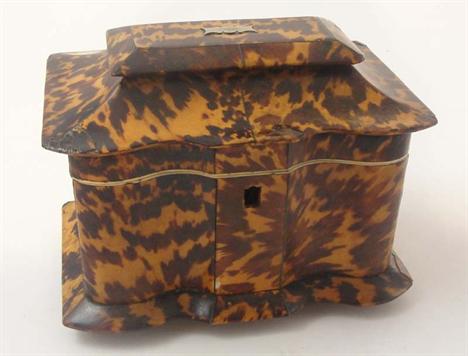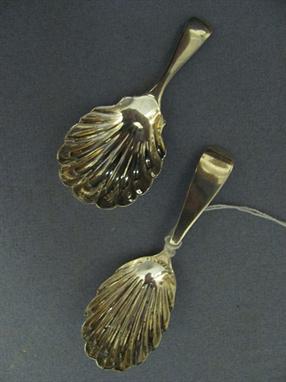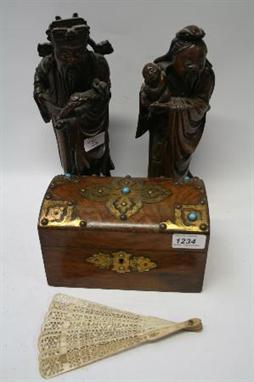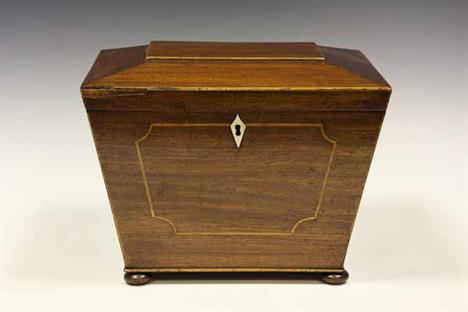81699 Preisdatenbank Los(e) gefunden, die Ihrer Suche entsprechen
81699 Lose gefunden, die zu Ihrer Suche passen. Abonnieren Sie die Preisdatenbank, um sofortigen Zugriff auf alle Dienstleistungen der Preisdatenbank zu haben.
Preisdatenbank abonnieren- Liste
- Galerie
-
81699 Los(e)/Seite
A George III mahogany cistern tube stick barometer George Adams, London, circa 1770 The rectangular brass vernier register (previously silvered) calibrated in inches with the usual observations and signed Made by G. Adams, Fleet Street, LONDON, Instrument Maker To His MAJESTY, above caddy moulded trunk with exposed tube and hemispherical cistern cover to the rounded base with level adjustment screw to underside, 98cm (3ft 2.5ins) high overall. George Adams was born circa 1704, he became free of the Clockmakers Company in 1754 and quickly established himself as one of the leading Instrument makers of the period being particularly well known for his globes and microscopes. In 1753 he advertised himself as `Instrument Maker to His Majest`ys Office of Ordnance` and subsequently was appointed Instrument Maker to the Prince of Wales later George III, several instruments made by Adams can now be seen in the George III collection at The Science Museum, London. George Adams died in 1772 leaving the business to his son also called George who also inherited the royal appointment. The current lot was probably made by George Adams senior towards the end of his career and according to the price list published in the 1769 second edition of his treatise would have cost £2-2s.
A George III inlaid mahogany bulb cistern tube stick barometer Leoni and Tarone, London, circa 1800 With broken triangular pediment above silvered vernier scale calibrated in inches, annotated with the usual observations and applied with an alcohol Fahrenheit thermometer beneath signature Leoni & Tarone, LONDON to upper margin, behind glazed door with ebony and box chevron strung edges above caddy moulded trunk with angled veneers within conforming parquetry borders, and domed cistern cover to the rounded base, 97cm high.
A fine and rare William IV mahogany cistern tube angle barometer in the manner of John Whitehurst of Derby Birchall, dated 1835 With square section finial to the cavetto moulded and gadrooned pediment above angled silvered glazed scale calibrated from 28 to 31 inches and divided into twentieths (0-300 over the length of the scale) with MUCH RAIN, Rain, Change, Fair, SET FAIR predictions and signed Birchall and dated 1835 to lower edge, the tube with brass setting pointer adjusted by turning the knurled brass finial at the end of the ogee shaped caddy terminal of the angled arm, the kingwood crossbanded and cockbeaded trunk with concealed tube and crossbanded borders to the figured veneers, the shaped base with half cylinder turned cistern cover with ring turned girdle and finials to top and bottom, 93cm (3ft 0.5ins) high. Banfield does not record a maker with the name Birchall working around this time however a M. Birchall is recorded in Baillie G.H. Watchmakers & Clockmakers of the World as working in Derby circa 1770-90. The current lot can be very closely compared to examples made by John Whitehurst of Derby during the latter half of the 18th century (for an example see Goodison, Nicholas English BAROMETERS 1680-1860 2nd ed. page 282). This suggests that this instrument was either made by a subsequent member of the Whitehurst family to be retailed by Birchall or is an accurately detailed version made by Birchall himself.
A Victorian carved oak quarter chiming bracket clock Edward F. Ashley, London, late 19th century The substantial four pillar triple fusee movement with rise/fall regulation and chiming the quarters on eight bells or four gongs and striking the hour on a further gong, the 11 x 8 inch foliate scroll engraved silvered Roman numeral dial signed EDW`D F. ASHLEY, 2 GREEN TERRACE, CLERKENWELL, LONDON to centre and with CHIME/SILENT, FAST/SLOW and CHIME ON 8 BELLS/WESTMINSTER CHIME subsidiary dials to upper margin, the case with two tiers of ball finials to the mansard roof caddy upstand incorporating balustrade to lower level, above scroll outline pilasters flanking dial and foliate pierced rectangular frets to sides, on deep oval fan cartouche carved plinth base with bun feet, 69cm (2ft 3ins) high. CATALOGUE ENTRY TO BE READ IN CONJUNCTION WITH IMPORTANT NOTES REGARDING THE CATALOGUING OF CLOCKS PRINTED IN THE SALE CATALOGUE OR AVAILABLE FROM THE SALEROOM ON REQUEST. An E.F. Ashley is recorded in Loomes, Brian Watchmakers & Clockmakers of the World, Volume 2 as working in London circa 1878.
A George II dark green japanned eight-day longcase clock with day of the week indication and moonphase John Spinney, Blandford, circa 1740 The five pillar rack and bell striking movement with 12 inch brass break-arch dial with ringed winding holes, subsidiary seconds dial and foliate scroll border-engraved apertures for date of month and day of week incorporating finely engraved deities to the matted centre, within an applied silvered Roman numeral chapter ring with fluer-de-lys half hour markers and Arabic five minutes to outer track, that angles with bird and urn cast spandrels beneath rolling moonphase to arch incorporating foliate engraved lunettes, calibrated lunar disc and applied arched nameplate JOHN SPINNEY OF BLANDFORD FECIT to upper margin, in a case with domed and stepped caddy above integral pilasters to hood and break-arch trunk door decorated in raised polychrome and gilt with figures and exotic birds within an oriental garden landscape, with gilt scroll decoration to surround, on similarly decorated plinth with moulded double skirt base, (with restoration), 239cm (7ft 10ins) high. CATALOGUE ENTRY TO BE READ IN CONJUNCTION WITH IMPORTANT NOTES REGARDING THE CATALOGUING OF CLOCKS PRINTED IN THE SALE CATALOGUE OR AVAILABLE FROM THE SALEROOM ON REQUEST. Two makers with the name John Spinney (presumably father and son) were known to have worked from Blandford Forum during the eighteenth century producing mainly modest thirty-hour clocks. The current lot with its unusual day of the week indication to the dial departs from their usual product, hence was possibly made to special order by a wealthy patron perhaps during the rebuilding of Blandford after the disastrous fire of 1731.
An oak eight-day longcase clock with ten inch dial Thomas Wise, London, circa 1690 and later The five finned pillar outside countwheel bell striking movement with anchor escapement, the 10 inch dial with subsidiary seconds dial and calendar aperture to the matted centre within applied silvered Roman numeral chapter ring with stylised sword hilt half hour markers, Arabic five minutes within the narrow outer track and signed Tho. Wise, London to lower edge, the angles with winged cherub head and scroll cast spandrels, the case now with canted caddy and cavetto cornice to the current hood above 42 inch rectangular trunk door and plinth base with later moulded skirt, (formerly ebonised, case with replacements), 209cm (7ft 5ins) high. CATALOGUE ENTRY TO BE READ IN CONJUNCTION WITH IMPORTANT NOTES REGARDING THE CATALOGUING OF CLOCKS PRINTED IN THE SALE CATALOGUE OR AVAILABLE FROM THE SALEROOM ON REQUEST. Thomas Wise was apprenticed to his father the eminent clockmaker John Wise in 1678, gaining his freedom in 1686 he worked form Fenchurch Street, London until his death in around 1698. The basic structure of the case of the current lot is sound and appears original to the movement and dial, hence this clock presents as an eminently worthwhile restoration project.
A fine William III quarter repeating ebony table clock with alarm Richard Colston, London, late 17th century The fully-latched seven finned pillar rack and bell striking movement with verge escapement and pull quarter repeat on three bells powered from the strike train, the foliate engraved backplate signed Rich: Colston, LONDON within a herringbone bordered oval reserve, the 7 inch square brass dial with alarm disc to the matted centre within an applied silvered Roman numeral chapter ring with Arabic five minutes, stylised sword-hilt half hour markers and with repeat signature to lower edge, the angles with unusual foliate scroll pierced gilt brass spandrels, the dial plate with S/N levers for silencing the strike and alarm above twelve o`clock, the case with scroll cast handle, applied gilt foliate mounts to caddy and vase finials above pierced frets to upper rail of door and above the rectangular side windows, on moulded base with turned brass feet, 36cm (14ins high) excluding handle. CATALOGUE ENTRY TO BE READ IN CONJUNCTION WITH IMPORTANT NOTES REGARDING THE CATALOGUING OF CLOCKS PRINTED IN THE SALE CATALOGUE OR AVAILABLE FROM THE SALEROOM ON REQUEST. Richard Colston was made Free of the Clockmakers Company by patrimony in 1682, he ceased to pay quarterage in 1702 and was believed to have died soon after this date. The current lot belongs to a rare group of table clocks which employ an unusual form of quarter repeat mechanism powered directly from the strike train (rather from a separate spring wound by pulling the repeat cord) which are discussed in Dawson, Percy G., Drover, C.B. and Parkes, D.W. Early English Clocks Pages 392-98, a very similar table clock by Colston is illustrated in Plates 564 (dial detail) and 663. The advantage of this layout is that it has freed-up enough space between the plates to allow for the provision of an alarm mechanism.
-
81699 Los(e)/Seite



















































